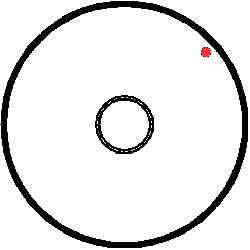One way of generating neutrons is by fusing D-D or D with T. In neutron generators that work by acceleration D-ions into a solid matrix of e.g. metal and T or D (metal hydrides). Such generators can produce up to 10^8 neutrons per second. I'm wondering, could they be tweaked to even higher levels to eventually produce a net amount of energy? The best result for the polywell was for example 10^9 fusions/sec, not far off from 10^8 fusions/sec.
-
2$\begingroup$ They are "fusion reactors" already. What they aren't is "fusion power" because you put in more energy then you are able to get out. Do you have any reason to think that running them at higher power will improve their efficiency? $\endgroup$– dmckee --- ex-moderator kittenCommented Feb 6, 2013 at 2:11
-
$\begingroup$ Do you have any idea how many fusions per seconds and volume would need to take place to have a self-sustained fusion with a net-energy output in a metal lattice or in a setup described by Anna (see below)? $\endgroup$– user20638Commented Feb 6, 2013 at 21:11
-
1$\begingroup$ Do you have a reference for 10^9 neutrons in PolyWell? As far as I remember, they were making very far reaching extrapolations based on a handful of detected neutrons. $\endgroup$– BarsMonsterCommented Feb 18, 2013 at 4:42
-
$\begingroup$ One point never brought up in these energy break-even challenges for nuclear fusion is the energy needed to enrich, refine, and produce the main fuels of deuterium and tritium. I understand that these are energy intensive processes. If we ever do get to energy break-even in the reactor phase, will we ever reach break-even for the whole process? $\endgroup$– 0tyranny0povertyCommented Oct 1, 2017 at 6:59
2 Answers
Neutron generators use a solid target, metal lattice filled with D2 or tritium, metal hydrides. The fusion reactions
D + T → n + 4He En = 14.1 MeV
D + D → n + 3He En = 2.5 MeV
happen within the lattice, most of the neutrons escape since they do not interact electromagnetically and generate the neutron source. There is no way a self sustaining reaction could exist within the lattice using the above energies so that the balance of (output energy -input energy ) could become positive and thus be an energy source.Interestingly there exist simpler neutron generators, patented and sold .In their own words:
IEC is the simplest way to achieve sustained nuclear fusion. While the possibility to scale the technology up to achieve more power output than input can be debated, there is no doubt that the technology provides a credible neutron generator without the disadvantages of a solid target.
Italics mine.

A hollow transparent grid cathode (-) is surrounded by anode (+) at ground potential. Applying a very high voltage to a low pressure gas will induce a glow discharge.
The positive ions (shown as red spot) are attracted to the cathode. Ideally an ion will be channeled by the electrostatic focusing to pass through the the cathode grid apertures. If there were to be no collisions with other ions and neutral particles the ion may oscillate.
In reality the low pressure gas-plasma is still very dense so that there will be collisions of various types. Despite such energy loss mechanisms sufficient ions do get accelerated to kinetic energy levels over ~ 15 keV where fusion collisions can occur. The greater the applied voltage on the glow discharge, the greater is the probability of a fusion collision.
-
$\begingroup$ Anna, thank you for your answer. Based on what you've been writing about IEC's technology, do you have any idea how many fusions per seconds and volume it would take to have a self-sustained fusion with a net-energy output in a metal lattice or in IEC's setup? $\endgroup$ Commented Feb 7, 2013 at 19:39
-
$\begingroup$ Sorry, no I cannot say offhand. You should check the plasma literature for ITER, for example iter.org/factsfigures . The plasma temperatures are too high for the simple IEC set up, the anodes and cathodes will melt. That is why ITER has magnetic confinement. $\endgroup$– anna vCommented Feb 7, 2013 at 19:49
The best neutron generators in the world (~3E+11 neutrons/second for 24 hours continously) are from Phoenix Nuclear Labs in Madison, Wisconsin. They are not doing solid targets, but gas based targets. Their machine is based on a fusor. But the design is very different. Electric fields do work on the ions - heating them to fusion conditions. That is the physical mechanism. In a fusors' case:

(1) Two wire cages with an electric field between them. (2) The ion accelerates. (3) It misses the inner cage. (4) It hits. It fuses. Naturally most of the ions hit the cage. This drives up conduction losses. This is a term in the Lawson Criterion for fusion power:
Power = Efficiency X (Fusion - Conduction - Radiation)
Because of the high conduction loss, fusors have been ignored for decades. Regardless, University of Wisconsin-Madison does the best fusor research in the world. Their HOMER machine has been well studied since the nineties. Dr. Gregory Piefer trained there before starting the company.
======
Phenoix llc. had a patent issued on 11/15/2012. This had sketches of their machine:


This is what it looks like assembled:

It is described as a gas target neutron generator. The company wants to use the high neutron fluency to make Molybdenum-99, a medical isotope.
===
Personally, I think the rest of the fusion world needs to wake up, to the exciting things happening in electrostatic confinement. We have our own textbook. We have very long list of unfunded amateurs who are doing nuclear fusion. We even hold the record for the youngest person in the world to do fusion: Jamie Edwards. Last week he was on the David Letterman Show discussing his fusor.

You can watch the Letterman clip here.
Cheers,
The Polywell Guy
